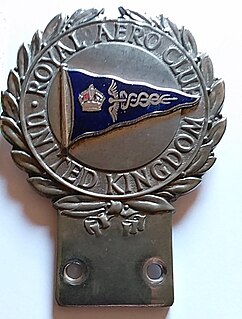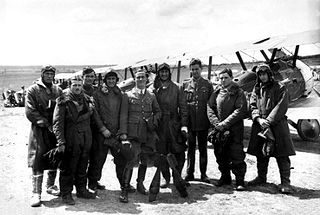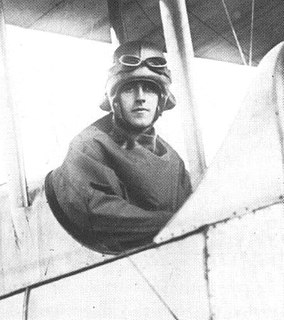
The Royal Aero Club (RAeC) is the national co-ordinating body for air sport in the United Kingdom. It was founded in 1901 as the Aero Club of Great Britain, being granted the title of the "Royal Aero Club" in 1910.

The Australian Flying Corps (AFC) was the branch of the Australian Army responsible for operating aircraft during World War I, and the forerunner of the Royal Australian Air Force (RAAF). The AFC was established in 1912, though it was not until 1914 that it began flight training.

Hendon Aerodrome was an aerodrome in London, England, that was an important centre for aviation from 1908 to 1968.

Air Chief Marshal Sir William Geoffrey Hanson Salmond, was a senior commander in the Royal Flying Corps during the First World War. Remaining in the Royal Air Force after the war, he held senior appointments in the Middle East, Great Britain and India. In 1933, Salmond served as Chief of the Air Staff for only a matter of days before being taken ill and subsequently dying from cancer.

The Central Flying School (CFS) is the Royal Air Force's primary institution for the training of military flying instructors. Established in 1912 at the Upavon Aerodrome, it is the longest existing flying training school. The school was based at RAF Little Rissington from 1946 to 1976. Its motto is Imprimis Praecepta, Latin for "The Teaching is Everlasting".

The Boxkite was the first aircraft produced by the British and Colonial Aeroplane Company. A pusher biplane based on the successful Farman III, it was one of the first aircraft types to be built in quantity. As the type was used by Bristol for instruction purposes at their flying schools at Larkhill and Brooklands many early British aviators learned to fly in a Boxkite. Four were purchased in 1911 by the War Office and examples were sold to Russia and Australia. It continued to be used for training purposes until after the outbreak of the First World War.

Royal Air Force Upavon or RAF Upavon is a former RAF station in Wiltshire, England. It was a grass airfield, military flight training school, and administrative headquarters of the Royal Air Force. The station opened in 1912 and closed in 1993, when it was transferred to the British Army and became known as Trenchard Lines.
Eustace Broke Loraine was a pioneer British aviator and the first Royal Flying Corps officer to be killed in an aircraft crash.
Major Sir Alexander Bannerman, 11th Baronet was a pioneer British military aviator.
Captain Horatio Claude Barber (1875–1964) was an early British aviation pioneer and First World War flight instructor. In 1911 he flew the first cargo flight in Britain, transporting electric light bulbs from Shoreham to Hove. He was also the first person in Great Britain to gain an aeronautical degree.
Group Captain William Victor Strugnell was a British First World War flying ace credited with six aerial victories. He went on to a long career in the Royal Air Force, and serving throughout the Second World War.

Henry Aloysius Petre, DSO, MC was an English solicitor who became Australia's first military aviator and a founding member of the Australian Flying Corps, the predecessor of the Royal Australian Air Force. Born in Essex, Petre forsook his early legal career to pursue an interest in aviation, building his own aeroplane and gaining employment as an aircraft designer and pilot. In 1912, he answered the Australian Defence Department's call for pilots to form an aviation school, and was commissioned as a lieutenant in the Australian Military Forces. The following year, he chose the site of the country's first air base at Point Cook, Victoria, and established its inaugural training institution, the Central Flying School, with Eric Harrison.

Eric Harrison was an Australian aviator who made the country's first military flight, and helped lay the groundwork for the Royal Australian Air Force (RAAF). Born in Victoria, he was a flying instructor in Britain when, in 1912, he answered the Australian Defence Department's call for pilots to form an aviation school. Along with Henry Petre, he established Australia's first air base at Point Cook, Victoria, and its inaugural training unit, the Central Flying School (CFS), before making his historic flight in March 1914. Following the outbreak of World War I, when Petre went on active service with the Mesopotamian Half Flight, Harrison took charge of instructing student pilots of the Australian Flying Corps at CFS.
Air Commodore Andrew George Board was an English soldier and airman. He was a pioneer aviator, first gaining a licence in 1910, who later became an air commodore in the Royal Air Force.
Group Captain George Bayard Hynes was an early pioneer English aviator, one of the first Army pilots. He was awarded the DSO during service with the Royal Flying Corps during the first world war, retired as a Royal Air Force Group Captain in 1931 and became the deputy director of aeronautical inspection in the Air Ministry.
Captain Thomas Laurence Purdom was a Scottish World War I flying ace credited with 13 confirmed aerial victories.

Lieutenant-Colonel James Valentine was an early English aviator who died during the First World War, serving in the Royal Flying Corps.
Brigadier-General Cuthbert Gurney Hoare was an officer of the British and Indian Army, who served in the Royal Flying Corps during World War I, and as the commander of Royal Flying Corps Canada.










